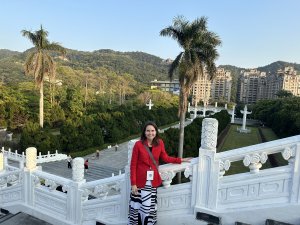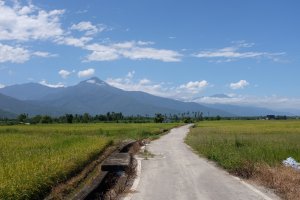I’m a Senior Scholar and visiting researcher who studies air pollution in the College of Public Health at National Taiwan University. My primary appointment is Professor of Civil and Environmental Engineering at Virginia Tech, where my research group applies quantitative methods to track the emissions, transformations, and fate of gases and particles in indoor and outdoor air. When people find out what I study, they often exclaim, “The air pollution is so bad in Taipei!” While vehicle exhaust along busy streets is often noticeable, in general, Taipei’s air quality is relatively good compared to that of other large cities in Asia. In fact, this is one of the reasons why my family selected Taipei for our sabbatical.
How is the air quality in Taiwan?
The pollutant of greatest concern in Taiwan is fine particulate matter of diameter 2.5 microns and smaller (PM2.5); it is roughly 100 times smaller than the diameter of human hair. Exposure to elevated levels of PM2.5 can cause coughing, make it hard to breathe, and aggravate asthma. Long-term effects include cardiovascular disease, certain types of cancer, and ultimately, premature death. The World Health Organization estimates that exposure to PM2.5 is responsible for 7 million deaths per year, or about 12 percent of the total. Particulate matter is also the main cause of haze. Ozone, a colorless gas, can also be problematic, especially on hot and sunny days; it causes coughing, wheezing, and irritation of the eyes, nose, throat, and airways.
Scientists report air pollution to the public using the air quality index (AQI), a numerical and color-coded scale where a number below 100 means that air quality is good (green) or moderate (yellow), and a number above 100 means that air quality is unhealthy for sensitive groups (orange), unhealthy (red), very unhealthy (purple), or hazardous (brownish red).
Averaged across all of Taiwan, the AQI was good (green) or moderate (yellow) more than 80% of the time in 2017, as show in Figure 1. For comparison, the AQI fell in these ranges approximately 95% of the time across 35 major cities in the US in 2016. In Beijing, the AQI was good or moderate on only 15% of days in 2015.
In the western half of Taiwan, air quality is usually better in the north and worse in the south because there are more power-generating and industrial sources in the central and southern part of the country. In northern Taiwan, encompassing Taipei and New Taipei City, the AQI exceeded 100 on less than 5% of days for ozone and PM2.5 in 2017. However, in southern Taiwan around Kaohsiung, the AQI exceeded 100 on 14% of days for ozone and 20% of days for PM2.5 in 2017.
Figure 1. Frequency of values of the air quality index between 2014 and 2017 (years 103-106) in Taiwan. A value of 0-50 (green) is good, 51-100 (yellow) is moderate, 101-150 (orange) is unhealthy for sensitive groups, 151-200 (red) is unhealthy, 201-300 (purple) is very unhealthy, and 301-500 (brownish-red) is hazardous. From the Environmental Protection Administration’s “Air Quality Annual Report of R.O.C. (Taiwan), 2017.”
What are the main sources of air pollution in Taiwan?
Old scooters, poorly maintained cars, and diesel trucks are the major source of air pollution that people experience when walking around cities. Air quality can be worse at street-level than at monitoring sites, some of which sit on top of buildings, farther from traffic. Scooters can have either a two-stroke engine or a four-stroke engine. A two-stroke engine is much more polluting than a four-stroke engine because its design results in emissions of a lot of unburned gasoline. Even though scooters with two-stroke engines were no longer sold in Taiwan after 2004, nearly 2 million of them remain in use. The Environmental Protection Administration is planning to ban two-stroke scooters completely by the year 2020, and this change should substantially improve air quality at street-level, particularly of smelly gasoline vapors that react in the atmosphere to form PM2.5 and ozone.
Other sources also contribute to air pollution in Taiwan. A major source is the coal-fired power plant in Taichung. It is one of the largest plants in the world and is responsible for 15% of the PM2.5 emissions in Taichung. During my sabbatical, the worst air quality in Taipei occurred right after the Lantern Festival, partly due to fireworks and burning lanterns. The Environmental Protection Administration is working to implement policies to reduce emissions from these sources.
One source that Taiwan cannot control is China. Using data from the Environmental Protection Administration, a researcher in Taiwan estimated that, on average, 37% of PM2.5 in Taiwan originates from overseas sources, mainly China due to its proximity and notorious air pollution problem. Satellite imagery from NASA shows air pollution, particularly sulfates shown in white, repeatedly buffeting Taiwan from China, especially in November through February. As China works to improve its air quality, Taiwan should benefit, too.
Does it help to wear a mask?
Wearing a mask carries stigma in the US, although this changed during the 2018 flu season, when I suddenly saw photos of people wearing masks in my Facebook feed. It is not unusual to see people wearing masks in Asia and even in some cities in Europe. Does a mask actually help? The short answer is that it can’t hurt, and it could help. The long answer is that it depends.
A recent study of masks found that paper surgical masks were more effective than simple, rectangular cloth masks at reducing exposure to fine particles, although thick cloth masks with multiple layers can be effective. Best of all is a type of mask known as an N95 respirator. In any case, a tight fit is extremely important. Even the best quality mask will be ineffective if there are gaps around the edge. It is easier to get a good fit with masks that are shaped to conform to the face and that have straps that go all the way around the head rather than just around the ears.
Figure 2. The author wearing a mask that she purchased to help protect against particulate air pollution while bike commuting. On days with poor air quality, she wore an N95 respirator. These masks do not protect against gasoline vapors and other gases that contribute to air pollution.
What can you do?
Besides wearing a mask to protect your lungs, you can also make choices that will reduce your exposure and the amount of air pollution you produce. On sidewalks and at busy intersections, stay as far away as possible from traffic, as pollution levels drop off rapidly the farther away you get from the source. Instead of driving or taking a taxi, rent a YouBike if it’s practical. It’s only 5 NT for the first 30 minutes. Although Taipei’s traffic seems chaotic, I have found the city to be more bike-friendly than most in the US because some of the major roads have bike lanes on the sidewalks and because drivers are accustomed to looking out for bikes.
If you’re buying a scooter, consider an electric one. They’re much quieter and cleaner. Even though the electricity is generated by burning fossil fuels, it’s easier to control emissions at the power plant than from an individual scooter.
Look into alternatives to burning incense and paper money and fireworks to celebrate the holidays. Because energy and transportation go into almost everything we do and consume and because these two sectors are the ones responsible for most air pollution, any choices you make to save energy, streamline your transportation needs, and consume less stuff will contribute to improved air quality. On days with poor air quality, when the AQI is over 100, wear a mask, either a surgical one or a thick fabric one, or best of all, an N95 respirator, and make sure it fits tightly.
Beyond a certain stage of development, as countries become wealthier, they are able to dedicate more resources to protecting environmental quality. Awareness of air pollution in Taiwan is high, and it is likely that air quality will continue to improve in the future.
References
Chen, W.-C., 2016, EPA eyes ban on two-stroke vehicles, Taipei Times, 12 Aug 2016, p. 4, http://www.taipeitimes.com/News/taiwan/archives/2016/08/12/2003652971.
Cherrie, J.W., Apsley, A., Cowie, H., Steinle, S., Mueller, W., Lin, C., Horwell, C.J., Sleeuwenhoek, A., Loh, M., 2018, Effectiveness of face masks used to protect Beijing residents against particulate air pollution, Occupational and Environmental Medicine, 75(6), 446-452, http://oem.bmj.com/content/75/6/446.
Everington, K., 2018, China is single largest source of PM2.5 pollution in Taiwan, Taiwan News, 17 January 2018, https://www.taiwannews.com.tw/en/news/3342478.
Lowsen, D.H., Conway, G.A., 2016, Air pollution in major Chinese cities: some progress, but much more to do, Journal of Environmental Protection, 7(13), 2081-2094, https://www.ncbi.nlm.nih.gov/pmc/articles/PMC5569320/.
Platt, S.M., Haddad, I.EI., Pieber, S.M., et al., 2014, Two-stroke scooters are a dominant source of air pollution in many cities, Nature Communications, 5, 3749, https://www.nature.com/articles/ncomms4749.
Shakya, K.M., Noyes, A., Kallin, R., Peltier, R.E., 2017, Evaluating the efficacy of cloth facemask in reducing particulate matter exposure, Journal of Exposure Science and Environmental Epidemiology, 27, 352-357, https://www.nature.com/articles/jes201642.
Taiwan Environmental Protection Administration, Taiwan Air Quality Monitoring Network, Air Quality Annual Report of R.O.C. (Taiwan), 2017, https://taqm.epa.gov.tw/taqm/en/YearlyDataDownload.aspx.
US Environmental Protection Agency, Our Nation’s Air: Status and Trends Through 2016, https://gispub.epa.gov/air/trendsreport/2017.
World Health Organization, 2018, Air pollution, http://www.who.int/airpollution/en/.





